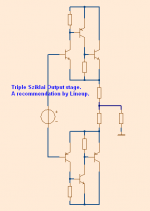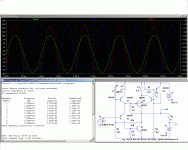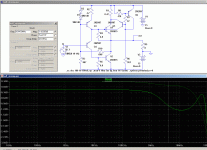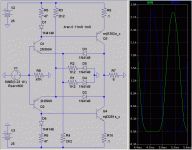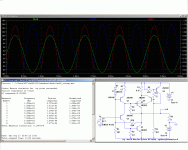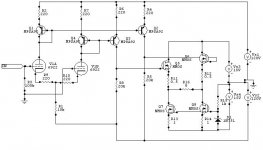Member
Joined 2009
Paid Member
I'm looking to make a simple impedance buffer, something that has a high Zin and a low Zout - whilst avoiding the high idle power dissipation of a Class A design. I don't want any feedback (except for degeneration perhaps).
Power requirements are low (e.g. <10W) so cross-over distortion at low power is perhaps the limiting factor.
Candidates include double EF, Krill O/P, Sziklai buffered EF, Diamond buffer.
What would you recommend and why ?
Power requirements are low (e.g. <10W) so cross-over distortion at low power is perhaps the limiting factor.
Candidates include double EF, Krill O/P, Sziklai buffered EF, Diamond buffer.
What would you recommend and why ?
Last edited:
SE class A?
J-fet input, use the -Vgs to bias a SE class A double EF.🙂 You could use a CCS for the J-fet source current, and a CCS to bias the output stage.
If class A is out of the question, then Diamond buffer is the way I would go.
Simple, functional.😎
J-fet input, use the -Vgs to bias a SE class A double EF.🙂 You could use a CCS for the J-fet source current, and a CCS to bias the output stage.
If class A is out of the question, then Diamond buffer is the way I would go.
Simple, functional.😎
Sziklai. My way of output.
I like Sziklai.
If you want a real killer, mainly for power and loudspeaker driving,
use something I call triple Sziklai.
We have normal 2T darlington.
And 3T triple darlington.
A Triple Sziklai is using 3 transistors, too.
The figure shows a Triple Sziklai
that simulates often better than triple darlington and anyhing else.
One other benefit, it has lower saturation voltage.
So can give a bit extra before clipping level.
Input impedance can be very, very high.
Like more than 1 MOhm I have measured.
MOSFETs and Triple Darlington steals voltage.
This is a factor especially when you have lower voltages and want to squeeze out max.
MOSFETs for example, can not work within 4-5 Volt of supply.
It all depends on your application.
For 10 Watt probably a double 2T Sziklai would do very well.
🙂
Now we will soon get some really wise guy coming here and discard Sziklai output.
Saying it is prone to oscillate.
Rubbish!
This is no reason against.
Because any amplifier, with any output, can oscillate.
We see this happen all the time under construction.
No. It is all about doing it right.
Whether we use the terrific Sziklai configuration or not.
Regards 🙂 Lineup
I like Sziklai.
If you want a real killer, mainly for power and loudspeaker driving,
use something I call triple Sziklai.
We have normal 2T darlington.
And 3T triple darlington.
A Triple Sziklai is using 3 transistors, too.
The figure shows a Triple Sziklai
that simulates often better than triple darlington and anyhing else.
One other benefit, it has lower saturation voltage.
So can give a bit extra before clipping level.
Input impedance can be very, very high.
Like more than 1 MOhm I have measured.
MOSFETs and Triple Darlington steals voltage.
This is a factor especially when you have lower voltages and want to squeeze out max.
MOSFETs for example, can not work within 4-5 Volt of supply.
It all depends on your application.
For 10 Watt probably a double 2T Sziklai would do very well.
🙂
Now we will soon get some really wise guy coming here and discard Sziklai output.
Saying it is prone to oscillate.
Rubbish!
This is no reason against.
Because any amplifier, with any output, can oscillate.
We see this happen all the time under construction.
No. It is all about doing it right.
Whether we use the terrific Sziklai configuration or not.
Regards 🙂 Lineup
Attachments
no feedback
I'm afraid Bigun himself will discard your proposal, as he "don't want any feedback (except for degeneration perhaps)".
Cheers,
E
I like Sziklai.
[snip]
Now we will soon get some really wise guy coming here and discard Sziklai output.
[snip]
Regards 🙂 Lineup
I'm afraid Bigun himself will discard your proposal, as he "don't want any feedback (except for degeneration perhaps)".
Cheers,
E
I'm looking to make a simple impedance buffer, something that has a high Zin and a low Zout - whilst avoiding the high idle power dissipation of a Class A design. I don't want any feedback (except for degeneration perhaps).
Power requirements are low (e.g. <10W) so cross-over distortion at low power is perhaps the limiting factor.
Candidates include double EF, Krill O/P, Sziklai buffered EF, Diamond buffer.
What would you recommend and why ?
I did lot of research about it. Finally my vote is the triple EF. I use tube VAS, so high input impedance is very important.
The CF has not very linear input impedance, what can be problem if no feedback applied. The diamond is good only for low power, or You have to use one more EF somewhere.
So my amplifier use triple darlington output. I carefully selected the components, and set the quiescent current.
Sajti
Member
Joined 2009
Paid Member
Thanks guys, I like these ideas.
Whilst I agree that the CFP (Sziklai) embodies some feedback, I'm willing to accept a single Sziklai pair as a 'compound device'. It's a bit of a stretch but I think it's a valid option. However, I would reject something like Hawksford as being a form of feedback too overt.
Do you guys have a feel in terms of sound - unwanted harmonics etc. between some of these options ?
I'm also thinking of a tube VAS (JFET is an alternative) so this is really a kind of hybrid. And so maybe I forgot to include Wavebourn Tower design as an alternative ?
Whilst I agree that the CFP (Sziklai) embodies some feedback, I'm willing to accept a single Sziklai pair as a 'compound device'. It's a bit of a stretch but I think it's a valid option. However, I would reject something like Hawksford as being a form of feedback too overt.
Do you guys have a feel in terms of sound - unwanted harmonics etc. between some of these options ?
I'm also thinking of a tube VAS (JFET is an alternative) so this is really a kind of hybrid. And so maybe I forgot to include Wavebourn Tower design as an alternative ?
Thanks guys, I like these ideas.
Whilst I agree that the CFP (Sziklai) embodies some feedback, I'm willing to accept a single Sziklai pair as a 'compound device'.
...................
>some feedback??? Well, of the order of 40dB. That's a little bit more than 'some'.
So what do you want? A decent low distortion buffer (based on feedback) or a high-end distortion generator (without feedback)?
Member
Joined 2009
Paid Member
Edmond - you are absolutely correct !
I better explain a bit more...
I have heard a no-feedback tube amp in my house and I very much like the sound. I don't want to build another global feedback amp after hearing this. Sure, there are some great gnf amps but life's too short to build them all so why not narrow down some choices ?
Whilst I like the sound of the tube amp, for a small desktop amplifier (such as one I might wish to use with my computer) a tube amp starts looking big, with two large output transformers for starters. So I am thinking of a hybrid with a single triode front end and SS output devices. If I do this with Class A I need huge heatsinks. So I am thinking Class AB SS outputs. I want to avoid feedback - but I simply don't know if Class AB without feedback is going to do the job adequately or if 'local' feedback can be 'allowed' without losing the sound I have heard from a no feedback amplifier. I do believe that if you are going to have any feedback at all, you have plenty of it and avoid the middle ground of just a little. The Sziklai has plenty of local feedback so perhaps it's OK, but perhaps it is not and the only way I could justify my feelings on this was to consider it a 'compound' device where the feedback loop is sufficiently 'local' as to be benign. But I have no experience to judge this. So I'm seeking opinions. I may simply stick with an all-tube amp if this is the best option.
I didn't want my first post to be a long read but may be I left out too much explanation, I hope the above helps.
I better explain a bit more...
I have heard a no-feedback tube amp in my house and I very much like the sound. I don't want to build another global feedback amp after hearing this. Sure, there are some great gnf amps but life's too short to build them all so why not narrow down some choices ?
Whilst I like the sound of the tube amp, for a small desktop amplifier (such as one I might wish to use with my computer) a tube amp starts looking big, with two large output transformers for starters. So I am thinking of a hybrid with a single triode front end and SS output devices. If I do this with Class A I need huge heatsinks. So I am thinking Class AB SS outputs. I want to avoid feedback - but I simply don't know if Class AB without feedback is going to do the job adequately or if 'local' feedback can be 'allowed' without losing the sound I have heard from a no feedback amplifier. I do believe that if you are going to have any feedback at all, you have plenty of it and avoid the middle ground of just a little. The Sziklai has plenty of local feedback so perhaps it's OK, but perhaps it is not and the only way I could justify my feelings on this was to consider it a 'compound' device where the feedback loop is sufficiently 'local' as to be benign. But I have no experience to judge this. So I'm seeking opinions. I may simply stick with an all-tube amp if this is the best option.
I didn't want my first post to be a long read but may be I left out too much explanation, I hope the above helps.
Last edited:
Hi Bigun,
First, thanks for explanation.
So you want tube sound. In that case, I would say: just use tubes and an output transformer, which is also part of the game, so to speak. If you need only 10Watts, then the O/P transformer doesn't need to be that big, provided that you are using a balanced output stage (as you know of course, a single ended class-A OPS, needs a much large one).
Cheers,
E.
First, thanks for explanation.
So you want tube sound. In that case, I would say: just use tubes and an output transformer, which is also part of the game, so to speak. If you need only 10Watts, then the O/P transformer doesn't need to be that big, provided that you are using a balanced output stage (as you know of course, a single ended class-A OPS, needs a much large one).
Cheers,
E.
Member
Joined 2009
Paid Member
Here is an unconventional suggestion:
It is a half-diamond circlo buffer.
It has a full NPN output, low-Z, good linearity, no crossover distortion, a servoed Iq control, and a decent bandwidth, even with 2N3055s.
Elvee, your description sounds great. But I'm struggling to understand how it works. I can sort of see the SE Diamond in there with Q4 and Q1, where Q3 provides a current source. But then it gets confusing. Everything seems connected to everything else. Can you walk me through it ?
Edit: thanks Wavebourn, just saw your post...
I would opt for a Black Devil but with a pair of 2SJ162/2SK1058
as power devices.
With moderate quiescent current, THD is very low and present
a perfect monotonic decrease..
The simulations i made about it just tell me how vastly underated
this old CFB amp is...
And yes, it has some GNFB...
as power devices.
With moderate quiescent current, THD is very low and present
a perfect monotonic decrease..
The simulations i made about it just tell me how vastly underated
this old CFB amp is...
And yes, it has some GNFB...
Member
Joined 2009
Paid Member
Hi Bigun,
First, thanks for explanation.
So you want tube sound. In that case, I would say: just use tubes and an output transformer, which is also part of the game, so to speak. If you need only 10Watts, then the O/P transformer doesn't need to be that big, provided that you are using a balanced output stage (as you know of course, a single ended class-A OPS, needs a much large one).
Cheers,
E.
I'm not convinced that 'tube sound' is a good description. I had experimented with SS amps that purport to sound tubey based on their harmonic profile. But although these modifications did make them sound better than without, they did not prepare me for the clarity and completeness of the sound I heard from my first tube amp (SE triode), which it'self is not particularly great because it's fairly high in 2nd harmonic.
So I am no longer interested in getting SS to sound 'tubey', it's the wrong way of thinking. I believe the thinking should be a) make SS sound as good as it can, b) make tubes sound as good as they can, c) don't make one of them immitate the other.
I'd rather try and get SS not to sound like anything at all.
I don't know how close to this experience a hybrid can come, but I figure that I would want a super-clean SS output, not one that makes for 'tubey' sounds. The input/VAS will be a triode, and I'd like the signature of this triode to shine through to the speaker where the SS buffer adds as little as possible of it's own.
You are right of course, the solution may still be an output transformer - and tubes all the way.
Q4 is the first stage of the half-diamond, but it also serves as a phase-splitter driving the two output transistors (forget Q5 and Q6 for now).Elvee, your description sounds great. But I'm struggling to understand how it works. I can sort of see the SE Diamond in there with Q4 and Q1, where Q3 provides a current source. But then it gets confusing. Everything seems connected to everything else. Can you walk me through it ?
The current delivered by Q3 is just twice the current needed to bias Q1 or Q2 at the onset of conduction, taking into account the B-E resistors R4 and R5.
In the quiescent state, Q4 derives half of Q3's current into the base of Q2, while the rest goes into the base of Q1.
When a signal is applied, it modulates the ratio of currents received by each output transistor, and the output operates in class B.
It is basically a "circlotron" topology (make a search on the forum), except Q4 is PNP, resulting in a unity gain circuit.
It is also called a "virtual complement", because the driver + N output synthetizes a N/P complementary pair, without using an actual PNP.
The circuit in this form wouldn't be thermally stable, and degeneration resistors would be required, degrading the output impedance, and creating crossover artifacts.
So, the bias current is in fact too low, and Q5 tops Q3, so that there is always enough current available in crossover region.
Q5 senses the collector current of Q1 via the shunt resistor R1, and has its Vbe compensated by Q6.
Q5 has to be thermally coupled to Q6, D1 to Q3, and D2 to Q1 and Q2.
Note that this circuit is just an example, and can (and should) be adapted to match the actual application.
Q1 and Q2 could be darlingtons or CFPs for higher output power and/or higher input impedance, and Q4 could be a CFP for a higher input impedance.
Attachments
Member
Joined 2009
Paid Member
So there's a bit of JLH going on here too with that phase splitter.
Have you or somebody else ever built this to try it out ?
Have you or somebody else ever built this to try it out ?
Edit: thanks Wavebourn, just saw your post...
My pleasure.
Any questions?
Q1 and D3 form a N-type LTP. Q2 and D2 form a P-type LTP. Q3 and Q4 each represent VAS for each opamp. They are loaded on each other, fully symmetrically. I.e. it is a complementary fully symmetrical opamp with 100% negative feedback.
For better linearity and thermal stability D1+R5/Q3R9 in the upper half and corresponding parts in the lower part form current mirrors.
Long tails are shortened intentionally: they are calculated for peak output current on max swing when the half in in class B phase. It prevents both hard clipping and output transistors' damage when output is overloaded. Don't apply GNFB around this stage, otherwise you will loose soft clipping!
You can turn it into class A symmetrical output stage: just remove R1,R2,D4,D5 and decrease R3 and R4 values.
I don't know how simple u want, but if no global feedback and class-A, this works ok.
The bridge mode prevents large offsets (due to temp drifts) at the output, which is kinda nice when u dont have GNFB to correct for the output's offset.
U will have some offset though, I think in mine it hovers around +-50mV, but that has never been a problem to my speakers.
The mirror type of circuit also makes an easy PP output if u add another pair of mirror transistors to drive the lower PP set of output transistors.
The bridge mode prevents large offsets (due to temp drifts) at the output, which is kinda nice when u dont have GNFB to correct for the output's offset.
U will have some offset though, I think in mine it hovers around +-50mV, but that has never been a problem to my speakers.
The mirror type of circuit also makes an easy PP output if u add another pair of mirror transistors to drive the lower PP set of output transistors.
Attachments
Oh by the way...why don't u build one of Nelson Pass' amps? Aren't many of them zero GNFB types?
Member
Joined 2009
Paid Member
Thanks SemperFi, that's a nice looking design and one day maybe this is the direction to go in. But at present, I'm not looking for Class A- it requires big heatsinks. These are large and bulky and can be expensive. In that case I may as well stick with output transformers and go all-tube. If I'm going to consider a hybrid, it has to be physically smaller than an all-tube option and without a huge $ penalty into the bargain. It should be possible given that transistors have displaced tubes in most applications, but I've added the kicker of no feedback and that ain't so easy when it's Class AB.
I'm also still trying to understand these designs from Wavebourn and Elvee...too many good ideas !
I'm also still trying to understand these designs from Wavebourn and Elvee...too many good ideas !
Last edited:
- Home
- Amplifiers
- Solid State
- Best topology for no-feedback ClassAB buffer ?
